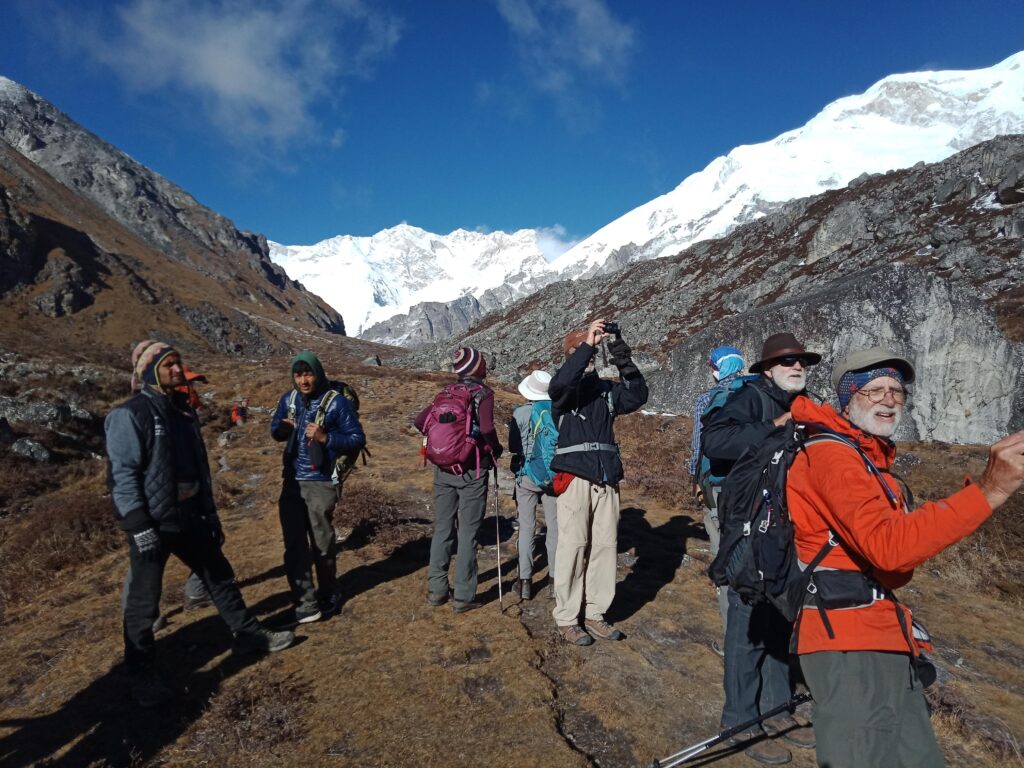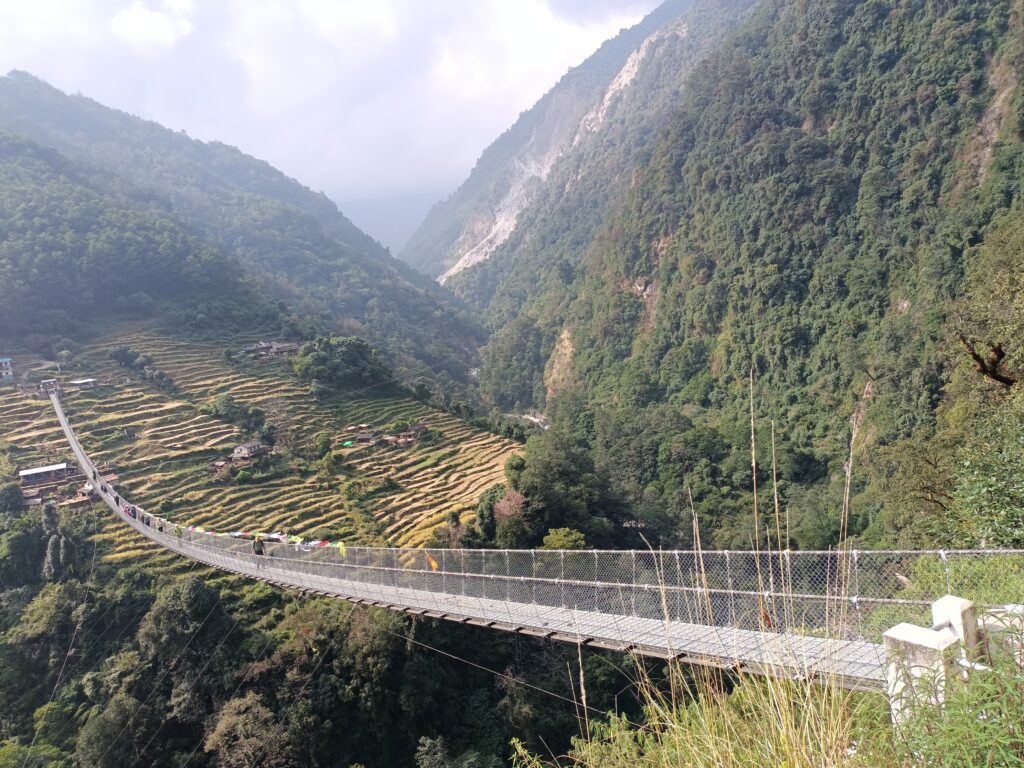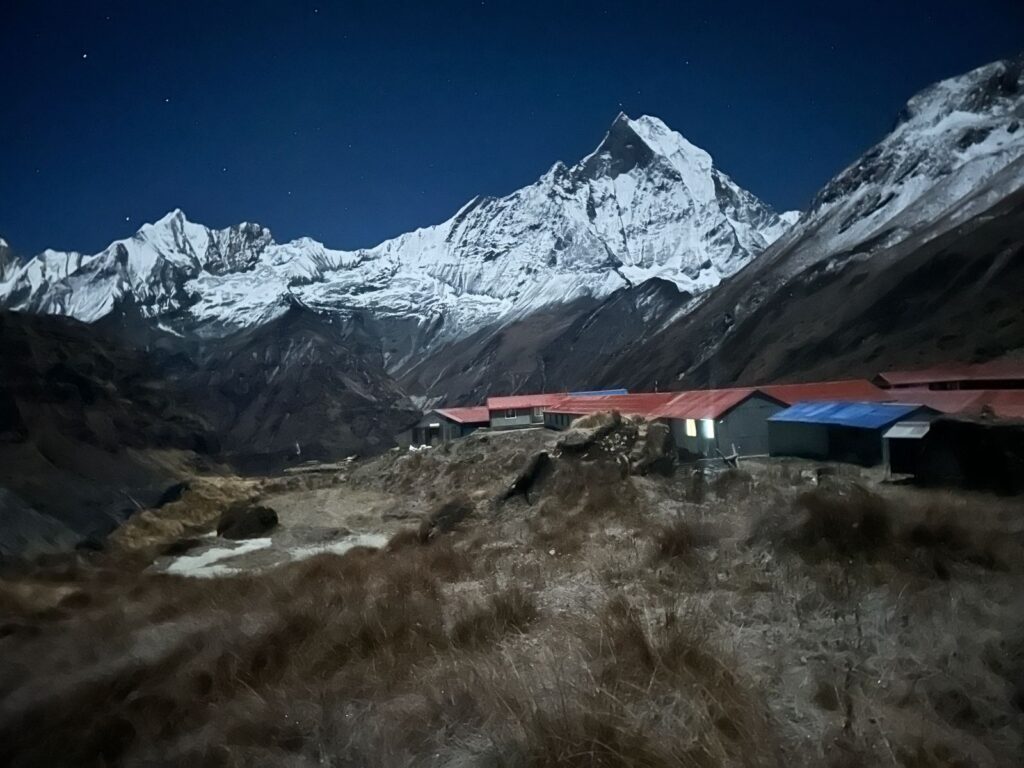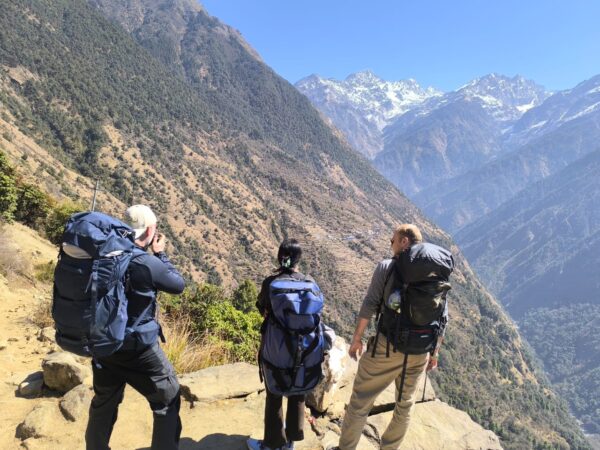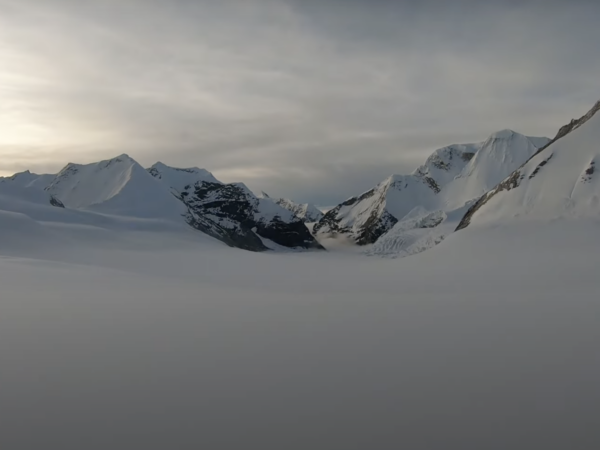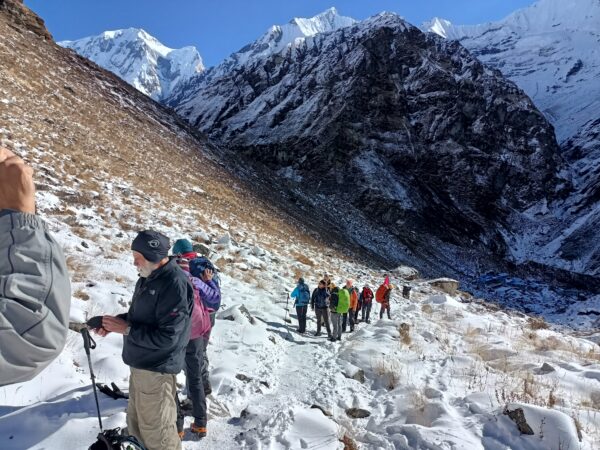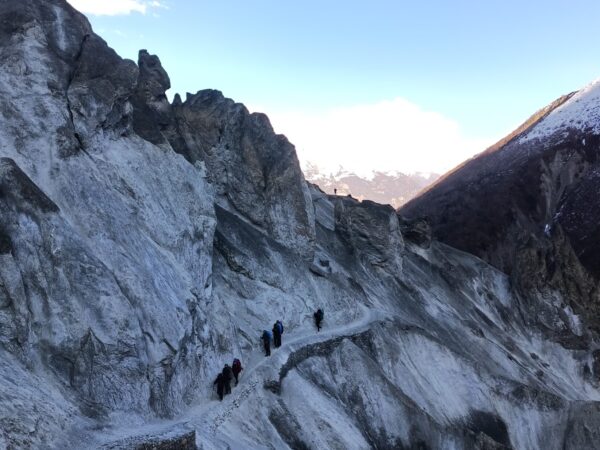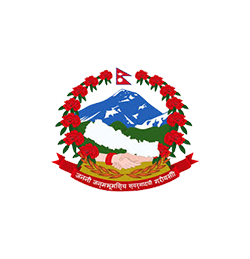- 1 - 1 pax USD$599
- 2 - 6 pax USD$499
- 7 - 15 pax USD$449
The Annapurna Base Camp Short Trek is a perfect adventure for those with limited time but an immense desire to experience the unparalleled beauty of Nepal. This moderate trek takes you through lush rhododendron forests, sparkling white-water rivers, terraced farmlands, natural hot springs, and charming Gurung villages. The journey culminates at Annapurna Base Camp, standing at 4,130 meters (13,550 ft), where you’ll be greeted by stunning vistas of towering peaks like Annapurna I, Machhapuchhre (Fishtail), Hiunchuli, and Gangapurna.
Highlights
- Immerse yourself in the vibrant tourist hub of Pokhara.
- Visit Ghandruk, a picturesque Gurung village with its museum and monasteries.
- Witness breathtaking mountain views at Annapurna Base Camp (4,130m).
- Unwind in the natural hot springs at Jhinu Danda.
- Marvel at iconic Himalayan peaks, including Annapurna South, Machhapuchhre, Hiunchuli, Khangsar Kang, and Gangapurna.
Why choose Annapurna Base Camp Short Trek?
The Annapurna Base Camp Short Trek is recognized worldwide by travel experts as a must-do journey for nature lovers and adventure seekers. It’s ideal for trekkers who wish to experience Nepal’s rich culture, diverse landscapes, and awe-inspiring mountain views within a limited timeframe.
This trek balances challenge and accessibility, making it suitable for beginner and seasoned trekkers alike. The journey is filled with cultural encounters, including visits to traditional Gurung villages, and natural wonders like rhododendron forests and glacial rivers.
What Makes This Trek Special?
The 7-day Annapurna Base Camp Short Trek is an exceptional alternative to longer treks, offering a condensed but equally rewarding experience. It’s one of the shortest Annapurna Base Camp trekking options, perfect for adventurers with limited time.
During the trek, you’ll traverse diverse terrains, from dense forests to alpine landscapes. The cultural experiences, combined with jaw-dropping mountain views, make this journey unforgettable.
Additional Benefits for Trekkers
- Complimentary airport transfers for a hassle-free start and end to your adventure.
- Simple and convenient booking process.
- Online trip briefing to address all your queries, including itinerary details and packing lists.
- 24/7 support through multiple communication channels (Email, WhatsApp, Viber, Zoom, etc.).
- Secure luggage storage during the trek.
- Use of pulse oximeters to monitor health at high altitudes.
- Access to medical kits and optional arrangements for sleeping bags and down jackets.
Online Trek Briefing
After booking, you’ll receive an online briefing that covers everything you need to know, from the trekking route to essential gear. This briefing ensures you’re fully prepared for the adventure ahead.
Best Time to trek Annapurna Base Camp Short Trek
Planning your trek to Annapurna Base Camp? One of the most important decisions you’ll make is choosing the right time of year to go. Each season brings its own unique beauty—and challenges. Here’s a simple guide to help you decide what suits your adventure style best:
Spring (March to May)
Spring is one of the most loved times to trek. The days are warm, the skies are usually clear, and the hills come alive with blooming rhododendrons. It’s a great season for both seasoned trekkers and first-timers looking for beautiful views and comfortable weather.
Note: May and June mark the start of honey hunting season in Nepal—a unique and ancient tradition practiced by local communities in the Himalayan foothills.
Autumn (October to November)
Autumn is peak trekking season in the Annapurna region. The air is crisp and fresh, the weather is stable, and the visibility is nothing short of spectacular. If you’re after postcard-perfect mountain views and ideal hiking conditions, this is your best bet.
Winter (December to February)
Trekking in winter is cold and more demanding—but it comes with its own rewards. The trails are quiet, the views are still stunning, and if you’re well-prepared for the chill, it can be a peaceful and unique experience away from the crowds.
Monsoon (June to September)
This is the least popular time to trek due to heavy rains, slippery trails, and cloud-covered peaks. But for those who don’t mind the wet weather, the trails are lush, the villages are less busy, and there’s a wild, raw beauty to the landscape.
Spring and autumn are by far the most popular seasons, thanks to their pleasant weather and amazing mountain scenery. But if you’re the type who enjoys quiet trails and doesn’t mind a challenge, winter might just be your season. And for the adventurous soul who doesn’t mind a little rain, the monsoon can offer a unique and refreshingly green perspective of the Himalayas.
| Season | Highlights |
|---|---|
| Spring (Mar–May) | Rhododendron blooms, warm days, clear skies |
| Autumn (Oct–Nov) | Ideal weather, amazing visibility |
| Winter (Dec–Feb) | Fewer crowds, cold but peaceful |
| Monsoon (Jun–Sep) | Lush trails, slippery paths, fewer trekkers |
Spring and autumn offer the best conditions, but every season brings a unique beauty.
At Everest Hikes, we’re here to help you find the right time to make your dream trek a reality—no matter the season.
Trek Difficulty and Physical Preparation
While this is considered a moderate-level trek, the 7-day itinerary can feel a bit intense, especially if you prefer a slower pace. For hikers with previous trekking experience, completing it in 7 days is quite manageable. However, if you’re new to trekking or want to take things at a more relaxed pace, we highly recommend our 14-day Annapurna Base Camp itinerary instead—it allows more time to enjoy the journey and acclimate comfortably.
To get the most out of your adventure, we suggest starting some light cardio—like brisk walking, jogging, or cycling—at least 15 to 20 days before your trip. A little preparation goes a long way in making your trek more enjoyable!
Outline Itinerary
Day 01: Drive from Kathmandu to Pokhara (820m) – 6-7 hours
Day 02: Drive to Ghandruk (1,940m) and Trek to Kumrung Khola (1,780m) – 4-5 hours
Day 03: Trek from Kumrung Khola to Sinuwa (2,360m) – 6-7 hours
Day 04: Trek from Sinuwa to Deurali (3,200m) – 6-7 hours
Day 05: Trek from Deurali to Annapurna Base Camp (4,130m) – 5-6 hours
Day 06: Trek from Annapurna Base Camp to Bamboo (2,310m) – 6-7 hours
Day 07: Trek from Bamboo to Jhinu Danda (1,780m), Drive to Pokhara – 5-6 hours trek + 2-3 hours drive
Facilities on ABC Short Trek
- Accommodation in Pokhara: Comfortable 2–3 star hotels (breakfast included).
- Teahouses on trek: Basic but cozy. Shared rooms common during peak season.
- Wi-Fi/Hot Showers: Available up to Chhomrong (may cost extra).
- Meals on Trek: All-inclusive—breakfast, lunch, and dinner. Dietary options (vegan, vegetarian, gluten-free) available on request.
Annapurna Base Camp Short Trek – 7 Days - Itinerary
Drive from Kathmandu to Pokhara (820m) – 6-7 hours
Start your adventure with a scenic drive from Kathmandu to Pokhara, 204 kilometers away. After enjoying a hearty breakfast at your hotel in Kathmandu, our team will pick you up for the journey. Traveling in a comfortable tourist bus, you'll pass through picturesque landscapes, with glimpses of small villages and rolling hills along the way.
As the journey progresses, you'll ride alongside the Trishuli River, offering serene views of the flowing water. We'll stop at Malekhu for lunch, a perfect break to stretch and enjoy a meal. After lunch, continue your journey, taking in the sights of terraced fields, forests, and distant mountains.
Upon reaching Pokhara, you'll find yourself in Nepal's vibrant tourist hub, filled with energy from both local and international travelers. Spend the night at a cozy 3/4-star hotel and prepare for the trek ahead.
Drive to Ghandruk (1,940m) and Trek to Kumrung Khola (1,780m) – 4-5 hours
After breakfast in Pokhara, a jeep will take you on a scenic three-hour drive to the beautiful village of Ghandruk. Nestled in the Annapurna region, Ghandruk is renowned for its Gurung culture, traditional homes, and stunning views of Annapurna, Machapuchare, and Himchuli.
Enjoy lunch in Ghandruk before starting your trek. The trail follows the banks of the Modi Khola, with fresh air and breathtaking surroundings creating an unforgettable trekking experience. After crossing the river, continue hiking past a massive boulder before arriving at the peaceful settlement of Kumrung Khola.
Trek from Kumrung Khola to Sinuwa (2,360m) – 6-7 hours
Begin your day with a warm breakfast before crossing the Kumrung Khola via a bridge. A steep uphill trail leads you to the charming village of Chhomrong, a traditional Gurung settlement.
From Chhomrong, cross the Chhomrong River and hike uphill through dense forests of bamboo, rhododendron, and oak. Along the way, take in spectacular views of Annapurna South and Machapuchare. The trail alternates between stone stairs and flat paths, offering a mix of challenges and breathtaking scenery. After a fulfilling trek, you'll arrive at the tranquil village of Sinuwa, where you'll stay for the night.
Trek from Sinuwa to Deurali (3,200m) – 6-7 hours
After breakfast, trek through lush forests to Kuldhighar, passing the serene Bamboo Village along the way. From there, the trail becomes steeper, with stone staircases leading to Dobhan.
As you continue, marvel at the scenic beauty of cascading waterfalls, small temples, and the famous Hiku Cave. The trail winds through forested landscapes as you approach Deurali. End your day with a hearty dinner and a restful night in a lodge at Deurali.
Trek from Deurali to Annapurna Base Camp (4,130m) – 5-6 hours
This is the highlight of your journey! Begin your trek along the Modi Khola, passing shepherds' huts before reaching Bagar. The trail becomes steeper and more challenging as you climb toward Machhapuchhre Base Camp (MBC).
Take a short break at MBC to soak in panoramic views of Machhapuchhre, Annapurna III, and surrounding peaks. From here, continue trekking through the Annapurna Sanctuary, a natural amphitheater surrounded by majestic snow-capped peaks.
Arriving at Annapurna Base Camp (4,130m), you'll be rewarded with awe-inspiring views of Annapurna I, South Annapurna, Hiunchuli, Tent Peak, and more. Spend the night at a lodge, immersed in the beauty of this extraordinary place.
Trek from Annapurna Base Camp to Bamboo (2,310m) – 6-7 hours
Wake up early to witness the sunrise over the Annapurna range—a truly magical experience. After breakfast, begin your descent. Retrace your steps to Machhapuchhre Base Camp, then continue to Deurali and finally to Bamboo.
The trail descends significantly, dropping over 1,700 meters in elevation. As you trek through lush forests and along the Modi Khola, enjoy the serenity of nature. Overnight at Bamboo.
Trek from Bamboo to Jhinu Danda (1,780m), Drive to Pokhara – 5-6 hours trek and 2/3 hours drive
On your final trekking day, hike through enchanting forests to Jhinu Danda, passing through Sinuwa and Chhomrong along the way. Cross the Chhomrong River via a suspension bridge and continue downhill to Jhinu Danda.
Relax at Jhinu's natural hot springs and enjoy the breathtaking views of lush landscapes and rolling hills. After lunch, a jeep will take you back to Pokhara, where your incredible journey concludes.
Inclusions
What's included
- International & Domestics Airport pick up and drop
- Standard Hotel accommodation in Pokhara (with breakfast included)
- An Experience English speaking guide
- All Meals and Teahouse accommodation during the trek
- Pokhara to Ghandruk and Jhinu to Bambo by Jeep
- Kathmandu - Pokhara - Kathmandu drive by tourist bus
- All required trekking permits (Annapurna Conservation Area Entry Fee and TIMS Card)
- Guide and porter insurance with food and accommodation
- Basic Medical kits
- Duffel bag, down jacket, trekking poles (should be returned after the trek
- Farewell dinner
- Emergency Helicopter Evacuation Service Arrangement Only (should cover by your travel insurance)
- All required paper works and government taxes
- Everest Hikes T-shirt
What's not included
- International Flight
- Nepal Travel Visa Fee
- Personal Medical and Travel insurance (Should cover helicopter evacuation)
- A porter (1 porter for every 2 trekkers, carry upto 25 kgs) - Cost USD $175
- Guide, Porter and Driver tips
- Personal Gears (equipment)
- Personal bill
- Lunch and Dinner in Kathmandu and Pokhara
- All other personal expense of beverages (hard and soft drinks)
- All other things not mentioned in the inclusion
Cost of Annapurna Base Camp Short Trek
Accommodation
- In Pokhara: Accommodation is included as per the itinerary, with comfortable 2 to 3-star hotel stays in Pokhara. We haven’t included accommodation in Kathmandu in this package, but if you’d like us to arrange it, we’d be happy to help. Airport pickup and transfers are already taken care of—you’ll be in good hands from the moment you arrive.
- On the Trek: Provided the best available lodges; during peak season, sharing a room with another same-sex trekker may be required.
Food
- Hotel Stays (Pokhara): Breakfast included; lunch and dinner are self-covered.
- On the Trek: All meals (breakfast, lunch, and dinner) are provided. Special dietary requirements (e.g., vegetarian, vegan, gluten-free, lactose-free) can be catered for if informed in advance.
Guide & Porters
- Guides: Led by government-licensed guides experienced in the trails. For groups over six, two guides are provided.
- Porters: One porter for every two trekkers during teahouse treks.
- Commitment: Safety and a memorable trekking experience are the main priorities.
Permits Required for Short Annapurna Base Camp Trek
- Annapurna Conservation Area Entry Permit: NRs. 3,000
- TIMS Card (Trekkers Information Management System): NPR 2,000
We arrange all permits for you.
Altitude Sickness and Safety Tips
When trekking to high elevations like 4,130 meters, altitude sickness is something everyone should be aware of. It doesn’t matter if you’re a seasoned trekker or just starting out—anyone can feel the effects of the thinner air at higher altitudes.
The good news? A few simple steps can help you stay safe and enjoy your adventure. First, make sure to acclimatize properly—take your time and follow the advice from your guide or our team. Staying hydrated is also key. Try to drink around 3 to 4 liters of water a day to help your body adjust.
It’s best to avoid alcohol during the trek, as it can make things worse at altitude. And if you’re concerned about altitude sickness, talk to your doctor before the trip about possibly taking Diamox (acetazolamide), which can help with prevention.
We prioritize your health and safety with:
- Pulse oximeters to monitor oxygen levels.
- First-aid kits available at all times.
- Guides trained in high-altitude safety.
- Optional Diamox (consult your doctor) for altitude sickness prevention.
Tips:
- Stay hydrated (3–4 liters/day)
- Avoid alcohol
- Listen to your body and your guide
With the right preparation, you’ll be giving yourself the best chance to have a safe and unforgettable journey.
Travel Insurance
- Recommendation: Essential to have travel insurance before trekking, particularly for accidents or emergencies requiring helicopter evacuation.
Requirement: Insurance should cover international medical emergencies and mountain trekking, and must be purchased in your home country.
Guide and Porter Support
- Guides: Professional, licensed, with 5+ years of experience.
- Porters: 1 porter per 2 trekkers. Carry your gear so you trek light and enjoy more.
How Much Should I Tip My Trekking Guide and Porter?
At Everest Hikes, our guides and porters are the heart of every journey. They’re not just helping you reach the destination—they’re sharing their knowledge, culture, and care every step of the way. While tipping is not compulsory, it's a kind and widely appreciated way to thank them for their effort.
Trekking staff earn a daily wage—usually around $25 for guides and between $18 and $20 for porters—but many rely on tips to support their families and communities, especially during trekking seasons.
We suggest budgeting about 10% of your total trip cost as a tip. This amount can be divided fairly between your guide and porters. If someone in the crew truly made your experience special, feel free to tip a little more—your generosity will be remembered long after the trek ends.
Your appreciation means a lot. Thank you for supporting the amazing people who help make the mountains feel like home.
A Typical Day on the Trek: What to Expect
Each day of the trek begins after a hearty breakfast, with trekkers gathering in the teahouse courtyard for a brief 10-15 minute morning warm-up to get the body moving. The trek typically starts between 8:00 and 9:00 AM, and we hike for around 6 to 7 hours, following the planned itinerary to reach the day’s destination. Lunch is usually taken along the trail, providing a refreshing break before continuing onward. Dinner is served at the teahouse where you’ll be staying for the night.
Given the 6 to 7 hours of trekking each day, which can be physically demanding, our experienced trekking guide will be with you every step of the way to ensure your safety and monitor your progress. They’ll offer support and encouragement, making sure you remain comfortable and energized throughout the trek.
Why Trek With Us?
- Licensed, local Sherpa guides
- 5+ years of experience
- Flexible group & private departures
- Emergency support & evacuation planning
- Eco-friendly & ethical trekking practices
Equipment
Recommended Trekking Gears
Clothing
- Base Layers (Moisture-Wicking)
- Thermal tops and bottoms (polyester or merino wool)
- Lightweight long-sleeve shirts
- Insulating Layers
- Fleece jacket or pullover
- Down jacket (for high-altitude treks)
- Warm sweaters
- Outer Layers (Shells)
- Waterproof and windproof jacket (Gore-Tex or similar)
- Waterproof pants
- Trekking Pants
- Quick-dry pants
- Convertible hiking pants (zip-off into shorts)
- Trekking Shirts
- Lightweight and breathable T-shirts
- Long-sleeve shirts with UV protection
- Headwear
- Wide-brim hat or cap for sun protection
- Warm beanie for cold temperatures
- Buff or scarf for dust and wind
- Gloves
- Lightweight trekking gloves
- Insulated gloves for higher altitudes
- Socks
- Moisture-wicking trekking socks
- Thermal socks for colder regions
- Footwear
- Sturdy and waterproof trekking boots (well broken-in)
- Comfortable sandals or camp shoes (for evenings/rest days)
- Gaiters (optional, for snow or muddy trails)
Backpacks & Bags
- Backpack
- 40-50L capacity for multi-day treks
- Comfortable straps and rain cover
- Daypack
- 20-30L for short treks or carrying essentials during the day
- Duffel Bag
- Used if porters are carrying your gear (for organized treks)
- Dry Bags
- To keep electronics and clothes dry in wet conditions
Sleeping Gear
- Sleeping Bag
- 4-season sleeping bag (rated for -10°C to -20°C for high-altitude treks)
- Sleeping bag liner (optional, for extra warmth and hygiene)
- Sleeping Pad (if camping)
- Lightweight and inflatable or foam pads for comfort
Trekking Accessories
- Trekking Poles
- Adjustable and lightweight poles (essential for steep ascents/descents)
- Water Bottle/Hydration System
- Insulated bottle (to prevent freezing at high altitudes)
- CamelBak or similar hydration reservoir
- Water Purification
- Water filters, purification tablets, or UV sterilizers
- Sunglasses
- UV protection (Category 3 or 4 for snowy conditions)
- Headlamp
- With spare batteries (essential for early morning or late-night treks)
- Multi-tool or Knife
- For various small tasks
- First Aid Kit
- Bandages, blister patches, antiseptic wipes, painkillers, Diamox (for altitude sickness), etc.
- Lip Balm
- SPF-protected to prevent chapping
- Sunscreen
- High SPF for UV protection at higher altitudes
- Personal Toiletries
- Biodegradable soap, toothpaste, toothbrush, quick-dry towel, wet wipes, and toilet paper
Optional but Useful Items
- Camera
- To capture the stunning scenery (extra batteries and memory cards are a must)
- Snacks
- Energy bars, trail mix, or chocolate for quick energy boosts
- Power Bank/Solar Charger
- For charging devices in remote areas
- Books or E-Readers
- For downtime during rest days
- Earplugs
- To block out noise in lodges or camps
- Notebook/Journal
- To record your trek experience
Clothing Packing Tips
- Layering is key: It helps regulate your body temperature and adapt to changing weather.
- Avoid cotton: It retains moisture and dries slowly, which can lead to discomfort or hypothermia.
- Pack light: Only carry what is absolutely necessary to avoid unnecessary weight.
Gear Rentals in Nepal
If you're worried about carrying too much gear, trekking hubs like Kathmandu and Pokhara offer trekking equipment rentals and sales. You can find items like sleeping bags, down jackets, and trekking poles at reasonable prices. However, ensure you check the quality before renting.

